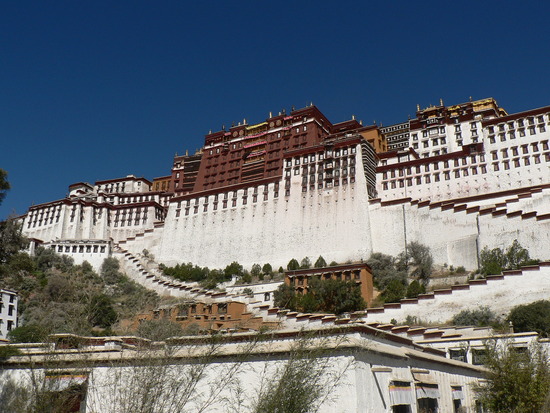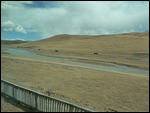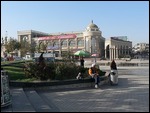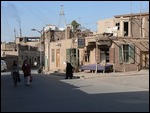
The Distant Chinas - A Journey to the Frontiers of Tibet, Central and Far North-West China
This is the story of a journey that we undertook in 2007 to the frontier regions of modern China - to the remote Tibet and the distant provinces of Yunnan, Qinghai, Gansu and Xinjiang. We were fascinated with the history of the old trading routes through China and keen to explore the ancient trading cities and their desert environment, as well as gaining an understanding of the local peoples, their customs and their culture. We were especially keen to travel in the footsteps of the brave souls who traded along the treacherous Old Silk Road routes. Our journey took us from Shanghai to Zhongdian (Shangri-la), Yunnan in the south-east to nine days touring through the mystical Tibet, then travelling by the fabulous high train through central China across the wild and desolate high plains of Qinghai to the salt lake township of Golmud. We then headed north by public bus toward the oasis city of Dunhuang, flanking the mighty Taklamakan and Gobi Deserts in Gansu then headed west via the low lying Turpan oasis to the city hub of Urumqi and the magnificent Tian Shan Mountains and deserts of the huge province of Xinjiang. From here our travels led us south-west to the wonderful exotic frontier town of Kashgar then along the borders of Afghanistan and Tajikistan as far south as the fascinating township of Tashkorgan, the last Chinese outpost before the famous Karakoram Highway enters the mysterious country of Pakistan. Ethnically, culturally and geographically these provinces, and even regions within the provinces, are extraordinarily diverse and are virtual countries within a country. From our previous travels to China we were well aware of the diverse number of minority groups in the Yunnan Province of south east China - from the Tibetan featured Naxi, Dai and Bai people in the areas around the cities of Dali and Lijiang to the strongly Indo-Chinese influenced minority groups of the Xishuangbanna area on the Myanmar (Burma) and Laos borders. Our experiences on all our travels confronted any views we may have had of a mostly homogenous Chinese nation. But we were astonished that roughly a third of the land mass of China in the north-western region is populated mostly by Muslim people. "Were we really still in communist China?" we asked ourselves on many occasions. For if you travel north from the essentially devout Buddhist world of Tibet you enter the world of Islam - the religious faith that dominates this region to the far north and western borders with Central Asia and Pakistan, and of course beyond. And within this huge expanse is a treasure of diverse and exotic cultures, a myriad of desert environments, unique oasis cities and a history steeped in the fascinating history of the ancient Silk Road trading routes. The only curious constant from Tibet to Xinjiang is the hostile but hauntingly beautiful arid nature of a moonscape environment. My husband Alan and I travelled on our own as a privately organised tour coordinated by China Travel Service (CTS), Australia (including air travel to and from China and most accommodation in China). Our Travel Consultant was David Hu, Email: ctsdavid@chinatravel.com.au. Whilst CTS was as usual efficient and helpful, and the transport and accommodation they organised was first rate, we certainly could not say of the same for a number of of their sub-contracted travel companies. Despite our careful planning some many months in advance, it was very disappointing that time and time again we were let down by these agencies. As usual, it was largely due to the generosity of local people that these difficulties did not turn into major disasters. And despite these needless frustrations, our trip turned out to be a wonderful experience and we would thoroughly recommend our travels and the fascinating routes we took through The Distant Chinas.
Planned Dates
Oct 07, 2007 to Nov 05, 2007
Countries
2
Trip Map
Trip Entries
Sort First:
-
1
From Crowdy Head to Sydney - Our Journey Begins
Saturday, October 06, 2007
 Crowdy Head, New South Wales, Australia
Crowdy Head, New South Wales, Australia -
2
On the Eve - Our Journey to the Distant Chinas
Sunday, October 07, 2007
 Sydney, New South Wales, Australia
Sydney, New South Wales, Australia

-
3
A Brief Return to Our Favourite City of Shanghai
Monday, October 08, 2007
 Shanghai, Shanghai, China
Shanghai, Shanghai, China



-
4
Our Journey to Zhongdian, via Kunming
Tuesday, October 09, 2007
 Kunming, Yunnan Province, China
Kunming, Yunnan Province, China

-
5
Two Delightful Days in Shangri-la - "Paradise"
Wednesday, October 10, 2007
 Zhongdian, Yunnan Province, China
Zhongdian, Yunnan Province, China



-
6
Mystical Lhasa
Thursday, October 11, 2007
 Lhasa, Tibet, China
Lhasa, Tibet, China



-
7
Friendly and Not so "Ho-Hum" Tsedang
Saturday, October 13, 2007
 Tsedang, Xizang, China
Tsedang, Xizang, China



-
8
Rural Tibet - Our Desert Journey to Gyantse
Monday, October 15, 2007
 Gyantse, Xizang, China
Gyantse, Xizang, China



-
9
More of Rural Tibet - Our Trip to Shigatse
Tuesday, October 16, 2007
 Shigatse, Tibet, China
Shigatse, Tibet, China



-
10
Returning to Lhasa
Thursday, October 18, 2007
 Lhasa, Xizang, China
Lhasa, Xizang, China



-
11
Aboard the Lhasa Express - Lhasa to Golmud
Friday, October 19, 2007
 Golmud, Qinghai, China
Golmud, Qinghai, China



-
12
Salt Pans, Altun Shan and a Taklamakan Apparition
Saturday, October 20, 2007
 Dunhuang, Gansu, China
Dunhuang, Gansu, China



-
13
Lovely Dunhuang - An Oasis in the Gobi Desert
Monday, October 22, 2007
 Dunhuang, Gansu, China
Dunhuang, Gansu, China



-
14
Frenetic Liuyuan and our Rail Trip to Turpan
Tuesday, October 23, 2007
 Turpan, Xinjiang Uygur, China
Turpan, Xinjiang Uygur, China -
15
Toward Turpan - Our Welcome to Xinjiang Province!
Wednesday, October 24, 2007
 Turpan, Xinjiang, China
Turpan, Xinjiang, China

-
16
Tales of Turpan - Second Lowest Basin in the World
Wednesday, October 24, 2007
 Turpan, Xinjiang, China
Turpan, Xinjiang, China



-
17
Exotic Urumqi - As Far From the Sea as You Can Be
Friday, October 26, 2007
 Ürümqi, Xinjiang, China
Ürümqi, Xinjiang, China



-
18
Twenty Three Hours to Kashgar by Rail
Sunday, October 28, 2007
 Kashgar, Xinjiang, China
Kashgar, Xinjiang, China -
19
Our Introduction to the Frontier City of Kashgar
Monday, October 29, 2007
 Kashgar, Xinjiang, China
Kashgar, Xinjiang, China



-
20
A Driver Called Mukhtar - Travels to Tashkorgan
Tuesday, October 30, 2007
 Tashkorgan, Xinjiang, China
Tashkorgan, Xinjiang, China



-
21
Kashgar Old City, More Carpets and Abdul Karim
Wednesday, October 31, 2007
 Kashgar, Xinjiang Uygur, China
Kashgar, Xinjiang Uygur, China



-
22
On the Home Run - From Kashgar Back to Urumqi
Friday, November 02, 2007
 Ürümqi, Xinjiang, China
Ürümqi, Xinjiang, China



-
23
From Urumqi to Shanghai, Sydney and Home
Sunday, November 04, 2007
 Shanghai, Shanghai, China
Shanghai, Shanghai, China
-
24
Home In Crowdy Head and A Message to Our Readers
Monday, November 05, 2007
 Crowdy Head, New South Wales, Australia
Crowdy Head, New South Wales, Australia









































































